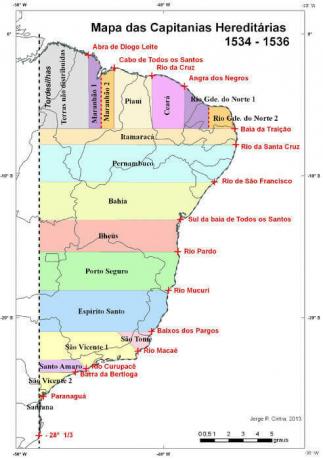THE Guaranitic War, or Guerra dos Sete Povos, was a conflict between Guarani Indians and Portuguese and Spanish troops, between 1753 and 1756, that resulted of the decisions of the Treaty of Madrid regarding the limits of the domains of Portugal and Spain in South America.
The disputed region was called Sete Povos das Missões and was originally occupied by priests Jesuits, who took the Indians from the Brazilian coast to the south of the colony in order to protect them from slavery and initiate evangelization. Portuguese and Spaniards disputed the region to imprison the Indians and use them as slave labor and search for precious metals.
Read too: Slavery in Brazil: forms of resistance
Historical context of the Guaranitic War
At the beginning of the colonization of America, Portuguese and Spanish tried to enslave the Indians to work at agriculture or in the extraction of precious metals. The Jesuits were against and, in Brazil, led the coastal Indians to more remote regions, almost close to the border of Spanish rule.
Far from the persecution of the settlers, the Jesuits were able to evangelize the indigenous people apart from the colonial exploitative logic. However, in the mid-eighteenth century, the expeditions scouts began the exploration of the Brazilian hinterland, reaching the Jesuit villages. The conflict happened because the religious would not hand over the Indians without resistance.
In some cases, the priests themselves handed over weapons so that the Indians could defend them from the bandeirantes attacks. These conflicts close to the border between Portuguese and Spanish domains required an agreement so that the boundaries could be demarcated.

Madrid Treaty
O Madrid Treaty, signed between Portugal and Spain in 1750, had as objective to demarcate the limits of domination among the colonizers. The Portuguese would cede the Sacramento region to Spain and, in exchange, would control the Sete Povos das Missões. According to the treaty, the indigenous and Jesuits who were on the Brazilian side had to cross the Uruguay River and move to the Spanish side.
This treaty did not please Indians and religious, because, in addition to moving from one region to another, the Spaniards were favorable to enslavement of indians. The Jesuits then decided to arm the Indians and fight for their land against the settlers.
Do not stop now... There's more after the advertising ;)
Causes of the Guaranitic War
The Treaty of Madrid was the main cause of the Guaranitic War. The Indians and the Jesuits opposed the changes decided by the treaty. O failure to comply with orders caused the Portuguese and Spanish troops to enter into confrontation against the revolting indigenous peoples.
How was the Guaranitic War?

The Guaranitic War took place between 1753 and 1756. The Jesuits handed over control of the missions to the Indians, but the Indian leader Sepé Tiaraju refused to change from the Portuguese to the Spanish side. The Spanish army was deployed to enforce the order, without success. The conflict spread to the region of La Plata. The Spanish were reinforced by the Portuguese and defeated the Indians at the Battle of Caiboaté, in 1756.
The colonizing troops were outnumbered and armed more powerfully than the Indians. The balance of the battle was the 1511 Guaraní deaths and only 4 European deaths. Soon after the battle, the Portuguese-Spanish army occupied the region of Sete Missões.
See too: War of Cisplatine – 19th century conflict for domination of the current region of Uruguay
End of the Guaranitic War
Soon after the end of the Guaranitic War, Portuguese and Spanish had to make other treaties to replace the decisions of the Treaty of Madrid. In 1777, the two crowns signed the Treaty of Itheredefofo, in which the Portuguese returned the Seven Missions to Spain. However, the Spaniards gave up the missions region after the Treaty of Badajós, signed in 1801.
Summary on the Guaranitic War
The Guaranitic War was a conflict involving Indians from the Guarani tribe against Portuguese and Spanish troops between 1753 and 1756, in the region known as Missões, in southern Brazil.
The main cause of the war was the Treaty of Madrid, which determined the transfer of Indians and Jesuits from the Brazilian side of the Uruguay River to the Spanish.
The colonizers defeated the Indians, but they had to establish other agreements to determine the borders between the two rulers of South America.
solved exercises
Question 1 – Mark the alternative that correctly points to the main cause of the Guaranitic War.
A) The dispute between Indians and settlers over gold mines in the region of La Plata.
B) The Indians refused to comply with the provisions of the Treaty of Madrid.
C) Revolt of Indians enslaved by Europeans.
D) The Jesuits clashed with Guarani Indians because of evangelization.
Resolution
Alternative B. The displacement of Indians from Portuguese to Spanish territory provoked a conflict between Indians and colonizers.
Question 2 – Read the alternatives below and mark the one that makes a true statement about the participation of Jesuit priests in the Guaranitic War.
A) The Jesuit priests armed the Indians to resist the attack of the colonizing troops.
B) The Jesuits supported the colonizers, which facilitated the victory against the Indians.
C) The religious declared war on Spain to remain in Brazil.
D) The Jesuits were punished by the Indians right after the victory in the Guaranitic War.
Resolution
Alternative A. The Jesuit priests had already established a good relationship with the Indians. To defend themselves from the attacks of the bandeirantes, they armed the Indians to defend the missions and the non-compliance with the Madrid Treaty.
Image credit
[1] Danúbio Gonçalves, photo by Eugenio Hansen / commons
By Carlos César Higa
History teacher
Would you like to reference this text in a school or academic work? Look:
HIGA, Carlos César. "Guaranitic Wars"; Brazil School. Available in: https://brasilescola.uol.com.br/historiab/guerras-guaraniticas.htm. Accessed on July 27, 2021.

